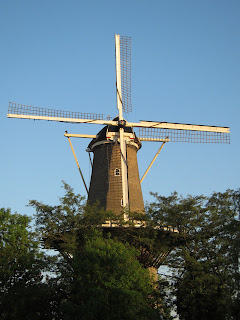Part 2: Leiden
I spent May 27–29 in Leiden studying the Wadjak 1 and 2 Homo sapiens material from Indonesia
(a.k.a., the former Dutch East Indies, hence why these specimens are in the
Netherlands instead of Indonesia).
Leiden is a university town, and while I didn’t see much of the
University, the town itself is very picturesque. I stayed in a pretty central and very nice
location, Hotel Mayflower, which was a welcome change of pace (noise wise) from my hotel in
Amsterdam! It was right on the major
central canal (which is a former part of the Rhine) and an open square area with restaurants.
 |
| The view from my hotel room in Leiden! |
On Monday I went to the Naturalis Biodiversity Center in Leiden. They have very modern storage
facilities (i.e., temperature and humidity controlled), which is good for the
collections, but I had to work in the same room with the collections which
meant that I got rather cold (it was kept at a constant 64oF or so,
which may not sound so bad, but when just sitting in one place it gets chilly)! They had a really nifty espresso maker
though, so when I needed a break I could make an espresso and stand outside in
the sun to warm up. J
 |
| What many museum storage facilities look like "behind the scenes" (i.e., what researchers study that's not on public display) |
It was really exciting to work in the “Collectie DuBois”
which consisted of many faunal specimens and a few hominin specimens collected
by Eugene Dubois, an early pioneer in paleoanthropology,
particularly in Indonesia. He was the
first to recognize the species Homo erectus
(which he originally named Pithecantrhopus
erectus) in the late nineteenth century.
In fact, he made a wooden statue for one of the World’s Fairs of what he thought Pithecantrhopus
erectus would have looked like based upon the skeletal material he’d
studied, and it happened to be *right* next to where I was working!
 |
| Pithecanthropus erectus statue created by Eugene Dubois. |
 |
| Pithecanthropus erectus statue right next to my workspace! |
However, I wasn’t there to study Homo erectus material (they don’t have any mandibles there), but
instead, I was there to study Wadjak 1 and 2, both early Homo sapiens. In fact, an article just came out dating them to much older than originally thought, which made
seeing these remains extra interesting.
Since I just saw 2 specimens there, I had some extra time to see the
Naturalis museum, which was really neat all around, but to me, especially because they had the original Homo erectus skull cap and femur on
display which I drooled over for a while as other visitors passed by.
 |
| Original Homo erectus skullcap and femur on display at Naturalis. |
 |
| The Trinil calotte. |
In all, Leiden was a lovely town with lots to see and
do. It was far more “Dutch” looking and
feeling than Amsterdam in terms of having old windmills to see.
And I also had a delicious apfelstruedel panenkoek!
 |
Apfelstrudel pannenkoek served on a traditional Dutch
pancake plate with apple cider at Oudt Leyden Pannenkoekenhuys.
|
On May 29 I took the train from Leiden back to the Amsterdam
airport and spent the night in a hotel near there before flying out to Lisbon
the next morning. I took a little stroll
around the hotel and saw these signs on parking spaces, wondering what they
meant:
I wondered if they were for pregnant women, although there
is no such designation, just “woman only.”
When I posed this question on Facebook Nick let me know that there are
designated parking spaces for women only near entrances and where security
cameras are facing to prevent assault.
I was unaware of this and found it interesting!





Schmoke and a pancake?
ReplyDeleteIs that some sort of pathology on the Homo erectus femur?
ReplyDeleteYes, it is a pathology! If you scroll down to the picture of the femur on Peter Brown's website, he gives a good brief explanation of it:
Deletehttp://www-personal.une.edu.au/~pbrown3/Trinil.html